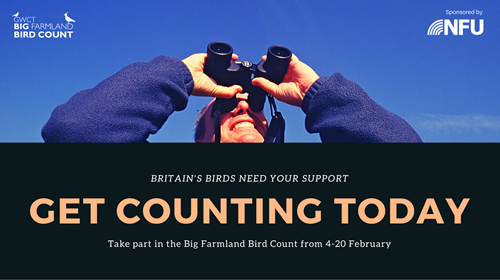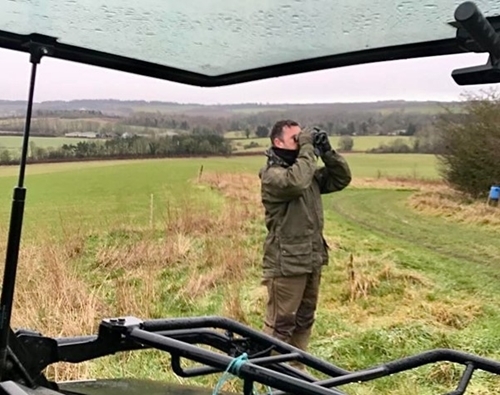
The 2022 GWCT Big Farmland Bird Count is now well underway, with only a week left to spend just 30 minutes counting the birds that share your land. Check out what some of our supporters had to say about the Big Farmland Bird Count and why they believe is it important to take part in this initivative.
Matthew Coupe, Allerton shoot keeper
"A rewarding morning seeing not only game but all wildlife appreciate our over winter feeding along with supplementary mixes during the hungry gap look forward to hearing them in the spring

Teyl de Bordes, Whitmuir Estate factor Selkirk, Scottish Borders
We find it help us gather data on the effect of over 20 years winter feeding of small farmland birds like the large mixed finch flocks. We have never had two counts with almost the same range of species seen. This shows the effect of the weather at the time. We tend to have more birds during snow events. We normally invite a different person to do the count each year. This helps us involve local birders in the work we do. The more farms take part the more valuable the data is.
Rob Shepherd, lead farmer, Allenford Farmer Cluster, Martin Down Super Cluster
'A key ingredient of the Farmer Clusters is the collection of species data across our landscapes.
The GWCT Big Farmland Bird Count adds to our understanding of the progress that our 'bottom up' conservation approach is achieving.'
Sarah Righton, Old Farm, Dorn, Moreton in Marsh, Gloucestershire
In 2011 we were involved in a survey with the RSPB, at this point there were around 30 species on the Red List and we recorded 6 on the farm. We have a 300 acre mixed farm, livestock and arable, small fields, mature hedges, pond areas and Simon plants wild bird cover crops in the spring to provide food for the birds over winter. We know we have plenty of birds around but I guess unless we sit down and take note of them we don't know which ones. Taking part in the Big Farmland Bird Count is a great opportunity to get involved on a national scale, there are now 70 birds on the red list and 103 on the amber list so the more people who get involved the better - we can see if what we have been doing over the last 11 years has made a difference and it will give us a starting point for planning what we can do in the future. The GWCT website has loads of information about how to identify birds and I have also downloaded an app (Smart Bird ID) - it records birdsong and gives you a best guess of who's singing! We've decided to invite our customers to come along and help us count on the 18th/19th February, details on our website:
www.oldfarmdorn.co.uk.
Martin Cook, Grange Farm, Whaplode, Lincolnshire
I am planning to carry out the count again as in previous years. We do the count for several reasons;
We are interested in providing different habitat environments for as many different species of flora and fauna as we can so as to enhance the biodiversity on our farm and to hopefully leave the farm in a better state for wildlife for the next generation.
We have been involved with several environmental schemes such as ELS, and now Countryside Stewardship Mid Tier, plus have many 4m wide grass buffer zones against our drainage ditches and have planted several lengths of mixed species hedges, but mainly Hawthorne,
We have a small wild pheasant shoot ( social ) using game cover crops and have been carrying out supplementary feeding from September to May for twenty odd years.
We are members of LEAF, Assured Crops and Assured Produce so to be able to show bird numbers as some sort of evidence of wildlife conservation is useful.
I find it interesting to see if these measures are making a difference and the count helps, although I am not seeing many songbirds this year in my usual counting spot, I certainly am seeing many , many more buzzards in my area, along with plenty of kestrels and sparrowhawks.
And finally I suppose as farmers, like many others we deeply care about the environment and our effect on it, and take great pride in trying to look after and enhance the bit of countryside we can directly influence, the bird count gives me a snapshot of ‘’what’s in my backyard’’.
Rufus Clarke, Horsted Keynes, Sussex
As farmers we have always had a love for wildlife and creating an environment in which it can thrive, whilst also retaining a shoot over 1000 acres. We have over 60 acres of water, split in to 23 ponds and lakes and many years ago we would see a vast array of wetland birds. Sadly, this is no longer the case and I am disturbed that year on year more birds enter the red list. 250 acres of woodland was wiped out in 1987 as a result of the hurricane - we have replanted 93 000 trees to date. The BOS have conducted surveys on the birdlife in the replanted plantations and also in virgin plantations and it is encouraging to see an increased variety of species that take up residence permanently and on their migrations. We make it a priority to cut and lay in the woodlands each year to encourage nesting habitats and cover and 90% of our cover crops are either nesting mixes or winter wild food mixes. What a treat it is to see finches that were once a rarity, hobbies, owls, woodpeckers (lesser, greater and green), dabchicks, long tailed tits, the fleeting appearance of the osprey on its migration.
The Big Farmland Bird Count not only allows us to find the time to concentrate solely on what we have in the woods and margins, but also to appreciate the nature on our doorstep. We can never have enough and that is why our role as custodians of their habitat is never ending.
How to get involved
Taking part in the BFBC is easy. Just pick one day between 4-20 February, download a count sheet from www.bfbc.org.uk and spend 30 minutes recording the number and species of birds seen on one area of land. Then submit your results via the website.
Bird identification guides and videos are available at www.bfbc.org.uk, along with guidance on how to support birds on farmland.
